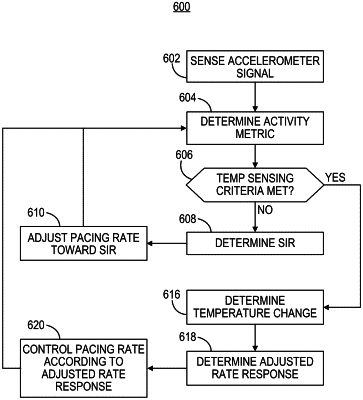| CPC A61N 1/36542 (2013.01) [A61N 1/3622 (2013.01); A61N 1/3624 (2013.01); A61N 1/3655 (2013.01)] | 25 Claims |

|
1. A medical device comprising:
an accelerometer configured to generate an acceleration signal;
a temperature sensor configured to generate a temperature signal;
a therapy delivery circuit configured to deliver cardiac pacing pulses at a pacing rate;
a memory configured to store a transfer function that relates an activity metric to a target cardiac pacing rate, the transfer function being defined by at least one slope and at least one set point; and
a control circuit configured to:
receive the acceleration signal and the temperature signal;
determine a first activity metric representative of patient physical activity from the acceleration signal;
determine from the acceleration signal a second activity metric representative of patient physical activity at a time later than the first activity metric;
determine the target cardiac pacing rate based on the second activity metric according to the transfer function;
determine that the second activity metric is equal to or greater than the first activity metric;
determine a temperature change from the temperature signal; and
in response to the second activity metric being equal to or greater than the first activity metric, determine an adjusted target cardiac pacing rate by:
adjusting the transfer function by adjusting at least one of the at least one slope or the least one set point based on the temperature change; and
determining the adjusted target cardiac pacing rate based on the second activity metric according to the adjusted transfer function; and
adjust the pacing rate according to the adjusted target cardiac pacing rate.
|